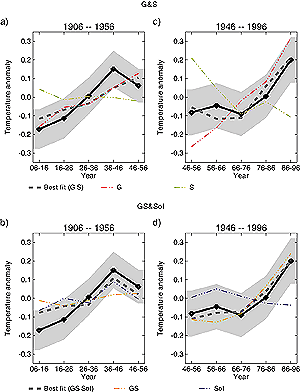12.4.3.3 Space-time studies

Figure 12.11: Best-estimate contributions to global mean temperature
change. Reconstruction of temperature variations for 1906 to 1956 (a and
b) and 1946 to 1995 (c and d) for G and S (a and c) and GS and SOL (b and
d). (G denotes the estimated greenhouse gas signal, S the estimated sulphate
aerosol signal, GS the greenhouse gas / aerosol signal obtained from simulations
with combined forcing, SOL the solar signal). Observed (thick black), best
fit (dark grey dashed), and the uncertainty range due to internal variability
(grey shading) are shown in all plots. (a) and (c) show contributions from
GS (orange) and SOL (blue). (b) and (d) show contributions from G (red)
and S (green). All time-series were reconstructed with data in which the
50-year mean had first been removed. (Tett et al., 1999). |
Here we consider studies that incorporate the
time evolution of forced signals into the optimal detection formalism. These
studies use evolving patterns of historical climate change in the 20th century
that are obtained from climate models forced with historical anthropogenic and
natural forcing. Explicit representation of the time dimension of the signals
yields a more powerful approach for both detecting and attributing climate change
(see Hasselmann, 1993; North et al., 1995) since it helps to distinguish between
responses to external forcings with similar spatial patterns (e.g., solar and
greenhouse gas forcing). The time variations of the signals can be represented
either directly in the time domain or transformed to the frequency domain.
Surface temperature
Tett et al. (1999) and Stott et al. (2001) describe a detection and attribution
study that uses the space-time approach (see Appendix 12.2).
They estimate the magnitude of modelled 20th century greenhouse gas, aerosol,
solar and volcanic signals in decadal mean data. Signals are fitted by general
linear regression to moving fifty-year intervals beginning with 1906 to 1956
and ending 1946 to 1996. The signals are obtained from four ensembles of transient
change simulations, each using a different historical forcing scenario. Greenhouse
gas, greenhouse gas plus direct sulphate aerosol, low frequency solar, and volcanic
forcing scenarios were used. Each ensemble contains four independent simulations
with the same transient forcing. Two estimates of natural variability, one used
for optimisation and the other for the estimation of confidence intervals, are
obtained from separate segments of a long control simulation.
Signal amplitudes estimated with multiple regression become uncertain when
the signals are strongly correlated (“degenerate”). Despite the problem
of degeneracy, positive and significant greenhouse gas and sulphate aerosol
signals are consistently detected in the most recent fifty-year period (Figure
12.11) regardless of which or how many other signals are included in the
analysis (Allen et al., 2000a; Stott et al., 2001). The residual variation that
remains after removal of the signals is consistent with the model’s internal
variability. In contrast, recent decadal temperature changes are not consistent
with the model’s internal climate variability alone, nor with any combination
of internal variability and naturally forced signals, even allowing for the
possibility of unknown processes amplifying the response to natural forcing.
Tett et al. (2000) have completed a study using a model with no flux adjustments,
an interactive sulphur cycle, an explicit representation of individual greenhouse
gases and an explicit treatment of scattering by aerosols. Two ensembles of
four simulations for the instrumental period were run, one with natural (solar
and volcanic) forcing only and the other anthropogenic (well-mixed greenhouse
gases, ozone and direct and indirect sulphate aerosol) forcing only (see Figure
12.4). They find a substantial response to anthropogenic forcing is needed
to explain observed changes in recent decades, and that natural forcing may
have contributed significantly to early 20th century climate change. The best
agreement between model simulations and observations over the last 140 years
has been found when all the above anthropogenic and natural forcing factors
are included (Stott et al., 2000b; Figure 12.7c).
These results show that the forcings included are sufficient to explain the
observed changes, but do not exclude the possibility that other forcings may
also have contributed.
The detection of a response to solar forcing in the early part of the century
(1906 to 1956) is less robust and depends on the details of the analysis. If
seasonally stratified data are used (Stott et al., 2001), the detection of a
significant solar influence on climate in the first half of the century becomes
clearer with the solar irradiance reconstruction of Hoyt and Schatten (1993),
but weaker with that from Lean et al. (1995). Volcanism appears to show only
a small signal in recent decadal temperature trends and could only be detected
using either annual mean data or specifically chosen decades (Stott et al.,
2001). The residual variability that remains after the naturally forced signals
are removed from the observations of the most recent five decades are not consistent
with model internal variability, suggesting that natural forcing alone cannot
explain the observed 20th century temperature variations. Note that Delworth
and Knutson (2000) find one out of five of their simulations with only anthropogenic
forcing can reproduce the early century global mean warming, including the enhanced
warming in Northern Hemisphere high latitudes. Hence a substantial response
to anthropogenic (specifically greenhouse) forcing appears necessary to account
for the warming over the past 50 years, but it remains unclear whether natural
external forcings are necessary to explain the early 20th century warming.
Continues on next page
